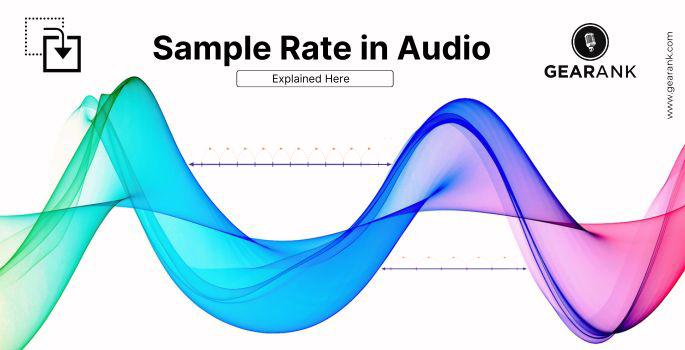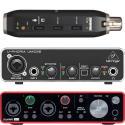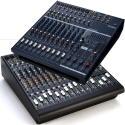What is Sample Rate in Audio? In Simple Terms

As an audio engineer, I get asked to explain what sample rate is in a language that is easy to understand. I have had plenty of practice, so I wanted to share this with you.
Here, I will explain to you my take on what sample rate in audio is, with an interesting spin to keep you awake.
I will be explaining:
-
How sample rate and bit depth affect audio quality.
-
What sample rate to use when bouncing a track.
Let’s get stuck into it with a touch of history to put things into context.
Digital Audio vs Analog Audio
How the need for Digital Audio arose
Back when computers weren't even a thing, we used to store original recording tracks on vinyl records, cassette tapes, and even cylinders (analog audio). Some of these were expensive and lost sound quality over time.
What if there was a cheaper way to store sound without the wear and tear, maintaining the best audio quality possible? This is where digital audio enters the picture.
Digital audio refers to the idea of storing sound in digital format, where an audio signal is converted into 1s and 0s (aka binary data). The data can then be stored, processed, and shared with other computers and devices.
Analog audio, in contrast, records or plays back a continuous electric signal where the original sound is mimicked via changes in voltage. The recorded signal is then stored in a vinyl or a cassette tape.
Digital audio has now become the industry standard, mostly due to how easy it is to manipulate sound. However, what's the process behind turning physical sound waves into editable, digital signal?
Converting Analog To Digital Sound Through Sampling
Technically speaking, every sound is analog before it becomes a digital audio recording. For instance, a singer singing through a microphone. You have electrical signals (analog) that pass through an audio interface (or a computer with analog to digital converters) and get processed through two crucial operations: sampling and quantization.
What is Sampling Rate in Audio?
Sampling is a process that involves taking samples, or snapshots of the audio signal at a specific rate (more about sample rate later). Sample rate in audio determines that many snapshots are taken per second. The moment each signal gets through, the computer takes note of the lowest and highest frequency range of the audio.
Quantization (bit depth)
Now, that the frequencies have been determined, quantization measures where the amplitude values, or levels of that recorded signal are. This determines how detailed you want to get with the snapshots taken. You can decide how loud or soft each are, and how clear to go with their dynamic ranges.
The range of these values is determined by the bit depth. Simply put, it's a setting where you can set how much volume it captures.
Sampling and Quantization. One captures audio snapshots, and the other assigns numeric values to determine their amplitude values.
Diving deeper into Sample Rate in Audio
If a video camera has a frame rate, meaning how many images it captures per second, the sample rate determines how many continuous snapshots of the sound waves are taken per second. And this process happens while your audio interface or computer is converting analog audio into digital. The higher the sample rate, the more you complete the picture, literally like a jigsaw puzzle.
Sample rate in audio is measured in Hertz (Hz), which represents the number of samples per second. Common sample rates used in digital audio production include 44.1kHz, 48kHz, 88kHz, and 96kHz.
Why does the sample rate start at 44.1 kHz?
To best illustrate this, think of when you last looked at a video on Youtube. It looked continuous because its frame rate was around 24-60 fps. If the frames were reduced to 2-8 per second, it will start looking like a slideshow.
Similarly in audio, 44.1 kHz is the standard "frame rate" (aka sample rate).
The scientific formula for this is called The Nyquist-Shannon theorem. It states that, in order to have an accurate sound reproduction, the sample rate has to be twice the frequency of the original recording.
The human ear can hear frequencies up to 20kHz. The reason why we record twice that is to avoid huge gaps between each sample, resulting in aliasing.
Aliasing happens when the sample rate is too low (meaning the time gap between samples is too large), resulting in some audio distortion or noise.
If you're curious at what different frequencies musical notes correspond to, you can look at a note frequency chart.
Standard Audio Sample Rates
So the next question is, what sample rate are you supposed to use? What are the settings that you are supposed to use for your situation?
44.1 kHz
A sample rate of 44.1 kHz is the standard format for audio CDs. The 44.1 kHz rate provides a frequency response of up to approximately 20 kHz, which is on the upper limit of human hearing. The 44.1 kHz sample rate will offer a balance between audio quality and audio file size. In other words, it’s the smallest file size, before you start noticing a drop in quality.
48kHz
This is a little higher than 44.1 kHz and is a sample rate that is most commonly used in video production, broadcasting, and digital audio workstations (DAWs, for example, FL Studio, Ableton, or Logic).
48 kHz provides a slightly extended frequency response compared to 44.1kHz and is considered a higher-quality option for recording and mixing. Producers like to work with this sample rate, as it gives them more control over the sound they are creating.
The reason 48kHz is used in video productions is to provide more headroom to catch higher frequencies.
88kHz-192kHz
Next up, we have much higher sample rates that are considered to be a high-resolution formats. 96 kHz in particular is used for high resolution audio.
They provide you with an extended frequency response, meaning producers can achieve much greater detail and accuracy in capturing audio signals. The downside is, since you're sampling the audio multiple times, you would need a lot of processing power and storage.
While the hearing range is only up to 20kHz, using a higher sample rate can be beneficial in a number of ways.
For starters, slowing down audio at lower sample rates can introduce aliasing. This is due to the fact that 44.1-48kHz will not be able to capture the finer intermediate details like higher sample rates.
Sound designers and foley artists prefer 92kHz, as they can stretch, slow down, or speed up a sound to their liking without introducing artifacts. That dinosaur sound from Jurassic Park is probably a slowed or pitched-down version of the human voice….but I digress.
This high sample rate is also commonly used in sound archives where capturing audio should be as hi-resolution as possible.
Some audiophiles swear that they can hear more nuances in an audio recording by listening to music sampled at this absurdly high rate, making it particularly advantageous for mastering music projects.
192 kHz has only a few applications. For instance, for bioacoustic research for wildlife and for audio software engineers testing the transient response at high sample rates.
If you're a creator, the audio sample rates below 196kHz will suffice (unless you want to experiment).
So in short:
44.1kHz: For standard CD quality audio and music production.
48kHz: For movies and films and can be used in music production to get more fidelity and headroom.
88kHz-192kHz: For sound design, foley, and sound archives. Projects that involve a lot of detailed documentation, or audio alteration.
192kHz can be used for acoustic and software research.
Understanding Audio Bit Depth Audio
Sample rate in audio describes how often the system has to take snapshots of the sound, how then is it represented and stored in numbers?
If you want to convert physical sound into digital, it makes sense to have a setting that can pack all the necessary details into a series 1s and 0s.
Under the hood, bit depth takes note of how small or big each individual amplitude is and assigns them their numerical values according to their levels. These are represented in "bits."
A lower bit depth has less data. It cannot accurately represent the actual dynamic range like a higher one can.
Bit Depths And Audio Quality
Bit depth is the setting that determines how deep you get with the dynamic range.
What does it mean to have a higher bit depth audio?
To be able to go "deep" enough to capture the softest and loudest sound possible.
You'll find that higher bit depth is important in music production, as it allows for more headroom for the mix. In these scenarios, preserving as much detail as possible can be crucial to capturing a crisp, detailed sound.
Here are the most commonly used settings and how they're used:
16-Bit
Originally started as a standard spec for CD audio. With a 16-bit depth, there are exactly 65,536 possible values that can be assigned to each sample.
This value allows for roughly 96dB, meaning it can represent both quiet and loud sounds within that range. Whether it be voice, electric guitar, or even a lawnmower, you'll be able to record audio with decent accuracy.
24-Bit
This is a high resolution setting for most streaming platforms. Having 16,772,216 possible values, 24-bit provides a dynamic range of roughly 144dB.
This range not only allows you to record explosion sounds for your next action movie. It's also becoming common practice for music producers and audio engineers to bounce in high-resolution.
Who doesn't want to hear the best version of our work right?
How Sampling Rate Affects Your System
As a technician, I've helped many users with their PCs and Macs. One recurring theme is resource management. This can happen if you have audio preferences that you incorrectly set during one of your sessions.
Here are a few tips that will help you manage your disk space and CPU resources.
44.1-48kHz won't put a big dent on your hard drive. However, the same recording in 88-192kHz is basically double, or even quadruple that file size.
This means more CPU processing power, more digital data, and more chances for CPU errors. Always check the sample rate and adjust it according to your available disk space.
Final Thoughts
Although the science can seem a bit intense, the practical applications of bit depth and sample rate in audio are straightforward.
Sample rate tells us how many times your computer should take snapshots of the audio while bit depth determines how high or low-resolution the snapshots should be.
We also need to take into consideration what equipment you use and what computer specifications you have.
These settings are just one of the tools to free yourself from technical constraints. Importantly, what matters is how we use them.
Whether producing music, beat making, or scoring for films, this understanding will put you on the right path.
Now you should read the FAQ Section below for a few more good tips.
Frequently Asked Questions
Can I Convert Audio Files From One Sample Rate To Another?
Yes, but there are a few things you need to know when converting from higher to lower sample rates and vice versa.
Converting an existing audio from 44.1kHz to 96kHz will not add more details to your existing audio.
On the other hand, if you have a 96kHz project and you convert it to 44.1kHz, some of the extra details from that higher sample rate can get carried over to the lower one.
Why did my audio speed up when I imported to a lower sample rate?
Let's say you imported a 48kHz audio to a 44.1kHz project. It's slowed down because you imported an audio double to its frequency range.
As a visual aid, think of opening a 4k photo with a monitor set to 1024p resolution. It will look really big (unless you zoom out). In audio, 88kHz will sound as if slowed down.
The solution would be sample rate conversion (SRC). Some DAWs automatically convert when you import a file with a different sample rate, while others give you the option to convert it manually.
Do I Need To Change A Sample Rate For Different Playback Devices?
This isn't something you'll need to do in most cases. Modern audio playback devices, for example, computers, media players, and smartphones are designed to handle a wide range of sample rates.
There are times when more complex playback devices may not be compatible, but this is rare, and the standard sample rate will be appropriate.
This principle also applies to the audio interface that you're planning on using.
Is a higher audio sample rate better?
It will depend on what you're going to do with the audio. For instance, if you're going to do lots of slowing down, stretching and make destructive alterations with the audio, then it's best to set it at a higher sample rate.
Keep in mind that a higher audio sample rate will also require tons of processing power and disk space, so you should be intentional with how you use these settings.
What audio sample rate and audio bit depth do streaming platforms typically use?
In music platforms like Spotify, Apple Music, TIDAL, etc… 44.1kHz/16-bit. Apple Music offers 44.1-192kHz and both 16-bit to 24-bit.
Video streaming platforms such as Youtube, Netflix, Amazon Prime Video, all use 48kHz/24-bit.
Contributors:
Allen Articulo - Co-writer











